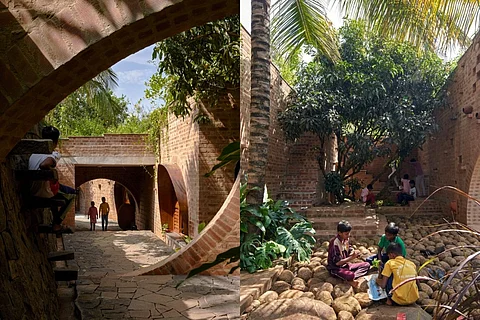
- HOMEGROWN WORLD
- #HGCREATORS
- #HGEXPLORE
- #HGVOICES
- #HGSHOP
- CAREERS
- ABOUT US
- CONTACT US

When we think of infrastructural development, we often imagine building structures on top of our land rather than within it. There is a distinct before and after; in this vision, natural vegetation and thickets of trees have to be flattened to the ground before we can create something new in their place. But what if we considered development as an opportunity to expand on what’s already there instead of replacing it?
A Threshold proves to us that nature doesn’t have to stand in opposition to architectural development. The homegrown architecture studio was first approached by a group of philanthropists to build a farmhouse in Kaggalipura, a village located 40km outside of Bengaluru. Though this project was initially meant for personal use, the studio had a different, more radical vision. Avinash Akalge, one of the founders of A Threshold, told Architectural Digest that the firm proposed to build a multifunctional, public space instead. Rather than serving just their investors, this space’s purpose would be to build community through various artistic, educational, and recreational opportunities.
This led to what Kaggalipura now calls the Subterranean Ruins, a winding set of rooms, courtyards, and recreational spaces spread over a 3-acre plot of farmland. The Ruins weave through the pre-existing flora in the area, leaving the area ripe with mango, avocado, and coconut trees while offering new infrastructure for Kaggalipura’s residents to use. The open-plan building seems to adapt and change with the land it’s built on. A Threshold maximised the area’s hilly terrain by creating small, cool recreational spaces where the land dipped and large courtyards where it was higher and more sunlit. They even created a rainwater collection system to make the most of the sloping landscape and help Kaggalipura’s farmers.
A Threshold’s community space is so well integrated into its surroundings that it almost looks like it emerged without human intervention. The name ‘Subterranean Ruins’ plays into this concept; the structure snakes through the land like a naturally occurring cave system and uses exposed brick walls, cobblestone floors, and abundant plant life to craft an organic, rugged aesthetic. Meticulous planning went into creating this illusion of naturalness.
The Subterranean Ruins are a masterclass in environment and community-oriented architecture. In an increasingly urbanised world, where our native landscapes are torn down time and time again to make space for copy-and-pasted grey highrises, A Threshold is showing there’s potential for another path forward.
Follow A Threshold here.
If you enjoyed reading this, here’s more from Homegrown:
Photography, Drawing, & The Art Of Memory: Inside The Visual World Of Sawani Chaudhary
A Story of Stripes and The City of Joy: How The Burlap People Reinvented The Bajaar Bag
The Stork Sisters: How A Grassroots Army Is Saving Assam’s Most Misunderstood Bird
